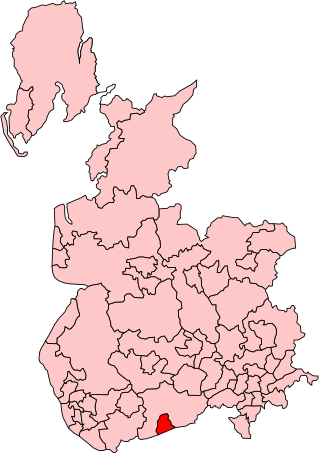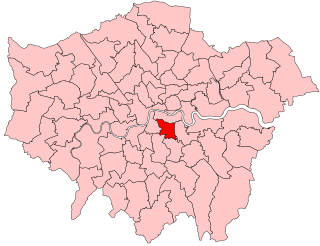Related Research Articles

Scarborough and Whitby is a constituency in North Yorkshire represented in the House of Commons of the UK Parliament since 2024 by Alison Hume, a Labour MP.

Llanelli is a constituency of the House of Commons of the Parliament of the United Kingdom. From 1918 to 1970 the official spelling of the constituency name was Llanelly. It elects one Member of Parliament (MP) by the first past the post system of election. Since 2005, it is currently represented by Nia Griffith of the Labour Party.

Blackburn is a constituency in Lancashire, England, which is represented in the House of Commons of the UK Parliament by independent politician Adnan Hussain. From 2015 to 2024 it was represented by Kate Hollern of the Labour Party and, from 1979 to 2015, by Jack Straw who served under the Labour leaders of Neil Kinnock and John Smith and the Labour governments of Tony Blair and Gordon Brown.

Ashton-under-Lyne is a constituency in Greater Manchester that was created in 1832. It has been represented in the House of Commons of the UK Parliament by Angela Rayner of the Labour Party since 2015. Rayner currently serves as Deputy Prime Minister and Secretary of State for Housing, Communities and Local Government in the cabinet of Keir Starmer, and was elected as Deputy Leader of the Labour Party in 2020.

Bristol West was a borough constituency represented in the House of Commons of the Parliament of the United Kingdom since 2015 by Thangam Debbonaire of the Labour Party. It mostly covered the central and western parts of Bristol.

Stourbridge is a constituency in West Midlands represented in the House of Commons of the UK Parliament since 2024 by Cat Eccles from the Labour Party.

Rugby is a constituency represented in the House of Commons of the UK Parliament since 2024 by John Slinger, of the Labour Party.

Stockton-on-Tees is a former borough constituency represented in the House of Commons of the Parliament of the United Kingdom. It elected one Member of Parliament (MP) by the first past the post system of election from 1868 to 1983.
Manchester Ardwick was a parliamentary constituency in the city of Manchester which returned one Member of Parliament (MP) to the House of Commons of the Parliament of the United Kingdom. Elections were held by the first past the post voting system.

Warrington was a parliamentary constituency in the United Kingdom. From 1832 to 1983 it returned one Member of Parliament (MP) to the House of Commons of the Parliament of the United Kingdom.

Peckham is a borough constituency in South London which returns one Member of Parliament (MP) to the House of Commons of the Parliament of the United Kingdom. Elections are held using the first-past-the-post voting system.

Salford North was a parliamentary constituency in the City of Salford in Greater Manchester from 1885 until 1950. It returned one Member of Parliament (MP) to the House of Commons of the Parliament of the United Kingdom.

Salford West was a parliamentary constituency in the City of Salford in Greater Manchester from 1885 until 1983. It returned one Member of Parliament (MP) to the House of Commons of the Parliament of the United Kingdom.
Wallsend was a parliamentary constituency centred on Wallsend, a town on the north bank of the River Tyne in North Tyneside.
Birmingham West was a parliamentary constituency represented in the House of Commons of the Parliament of the United Kingdom. It returned one Member of Parliament (MP), elected by the first-past-the-post voting system.

Plaistow was a borough constituency returning a single Member of Parliament to the House of Commons of the Parliament of the United Kingdom through the first-past-the-post voting system. The constituency was one of four divisions of the Parliamentary Borough of West Ham, which had at the time the same boundaries as the County Borough of West Ham. Although administratively separate since 1889, the area was formally part of the county of Essex; since 1965 it has been part of the London Borough of Newham in Greater London.
Birmingham Deritend was a constituency of the House of Commons of the Parliament of the United Kingdom from 1918 to 1950. It elected one Member of Parliament (MP) by the first-past-the-post system of election.
Manchester Exchange was a parliamentary constituency in the city of Manchester. It returned one Member of Parliament (MP) to the House of Commons of the Parliament of the United Kingdom, elected by the first past the post system.
Manchester Clayton was a parliamentary constituency in the city of Manchester. It returned one Member of Parliament (MP) to the House of Commons of the Parliament of the United Kingdom, elected by the first past the post system.

Manchester Rusholme is a parliamentary constituency centred on the Rusholme district of Manchester. It returned one Member of Parliament (MP) to the House of Commons of the Parliament of the United Kingdom, elected by the first past the post system.
References
- 1 2 "Parliamentary Borough of Manchester" in Schedule part II of "Report of the Boundary Commission (England and Wales), 1917", Cd. 8756.
- ↑ "Parliament", The Times, 30 November 1917, p. 12.
- 1 2 3 4 5 6 7 Craig, F.W.S., ed. (1969). British parliamentary election results 1918-1949 . Glasgow: Political Reference Publications. p. 191. ISBN 0-900178-01-9.